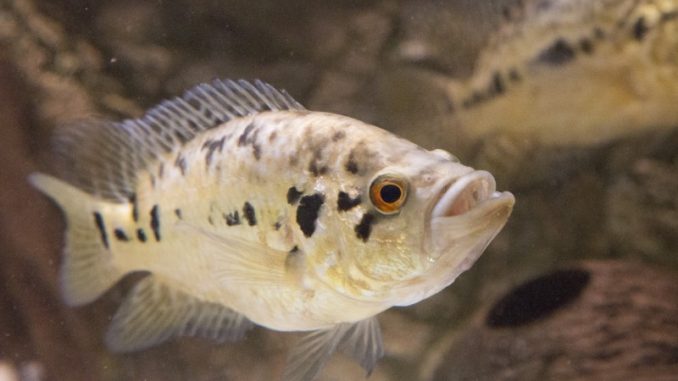
The jaguar cichlid is a freshwater fish belonging to the cichlid family. It is native to Central America and is often found in the lakes and rivers of Honduras and Costa Rica. The jaguar cichlid is popular with more experienced home aquarists who have the capacity for a large tank setup.
The jaguar cichlid is a large fish, reaching a length of up to 14 inches. It is silver with large black patches, with similar markings and coloration to a jaguar — hence its name.
An aquarist who is up for the challenge of caring for a large, aggressive fish will enjoy having a jaguar cichlid or two in their tank. The jaguar cichlid has a feisty temperament, making it tricky to keep in a communal tank.
TABLE OF CONTENTS
Jaguar Cichlid Facts & Overview
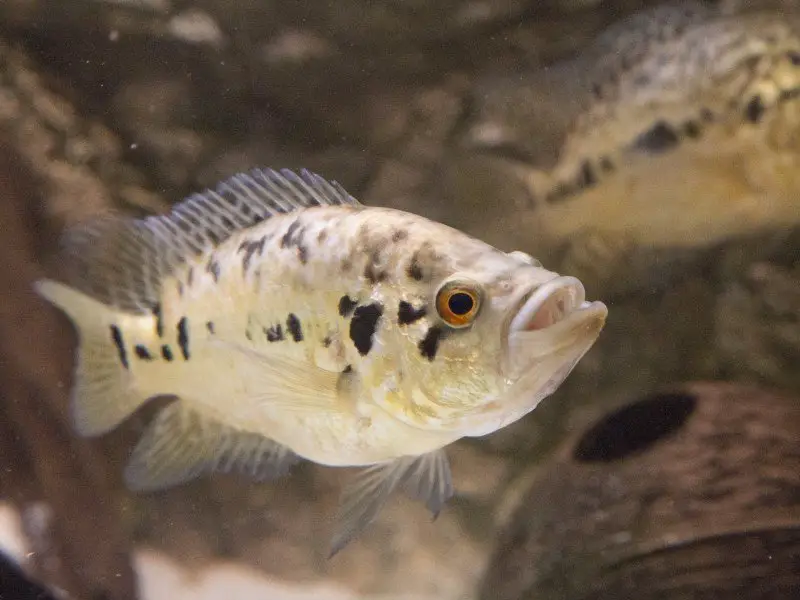
| Category | Rating |
| Care Level | Moderate to high |
| Temperament | Aggressive |
| Color | Silver or gold, with black patches |
| Lifespan | ~15 years |
| Size | 12–14 inches |
| Diet | Carnivore |
| Family | Cichlidae |
| Minimum Tank Size | 70 gallons |
| Tank Setup | Freshwater, rocks, caves |
| Compatibility | Other jaguar cichlids, and other cichlid species |
The jaguar cichlid is named for its resemblance to the jaguar, which has similar coloring and black markings. The fish’s scientific name is the Parachromis Managuensis. This name comes from Lake Managua, where the jaguar cichlid is commonly found.
You may also hear the jaguar cichlid referred to as the managuense cichlid, spotted cichlid, and jaguar guapote. The jaguar cichlid is very popular in Costa Rica, where it is usually called the guapote tigre.
Jaguar cichlids are native to the rivers and lakes of Central America, where the waters are murky and thick with vegetation. These fish enjoy tank setups that closely resemble their native environment.
The lifespan of a jaguar cichlid is approximately 15 years. Taking young jaguar cichlids into a home aquarium is a long-term commitment.
Jaguar cichlids are common in their native environment, where they are frequently found in rivers and lakes. They are tough and hardy and can survive in a variety of water conditions.
As a popular fish species, the jaguar cichlid is readily available in many pet stores. A young fish costs $10–$15. You can expect to pay close to $40 for a mature, fully grown specimen.
Appearance & Behavior
The jaguar cichlid has a striking appearance. It has a large, elongated body, with spectacular fins. When kept in captivity, a male jaguar cichlid can grow to a length of up to 14 inches, while a female will reach about 12 inches.
In the wild, the jaguar cichlid can be even bigger, reaching a length of up to 24 inches. It can weigh as much as 3.5 pounds.
The jaguar cichlid is usually silver in color, but can also be found in bronze or gold. A characteristic feature of this species is the large black splotches all over the body. These look more like thick black stripes around the fish when it is very young, but as the jaguar cichlid grows, these stripes tend to separate into blotches.
The male jaguar cichlid is usually longer than the female, and has a more elongated, oval shape, while the female has a more rounded belly. During the breeding season, the female jaguar cichlid’s rounded belly becomes even more pronounced as it fills with eggs.
There are many varieties of cichlids. All cichlids are fairly large, but the jaguar cichlid is one of the biggest varieties.
Typical Behavior
The jaguar cichlid is a highly aggressive fish. It will chase after, nip, bite, and eventually eat any smaller fish. You should take this into consideration when choosing tankmates for the jaguar cichlid.
Jaguar cichlids are territorial fish that will see any newcomers as a threat. If you want to keep more than one jaguar cichlid in the same tank, you should get them at the same time, and make sure the fish are similar in size. This will allow the jaguar cichlids to get used to each other from a young age, making them less likely to attack each other.
You should give your jaguar cichlid lots of space to swim around because it is an active fish. The jaguar cichlid enjoys hiding in caves and behind rocks, but will probably try to eat live plants. These fish spend most of their time close to the bottom of the tank, where they like to dig around in the substrate.
They are usually very active during the day, but they will settle down and rest quietly at the bottom of the tank during the night.
Jaguar Cichlid Care
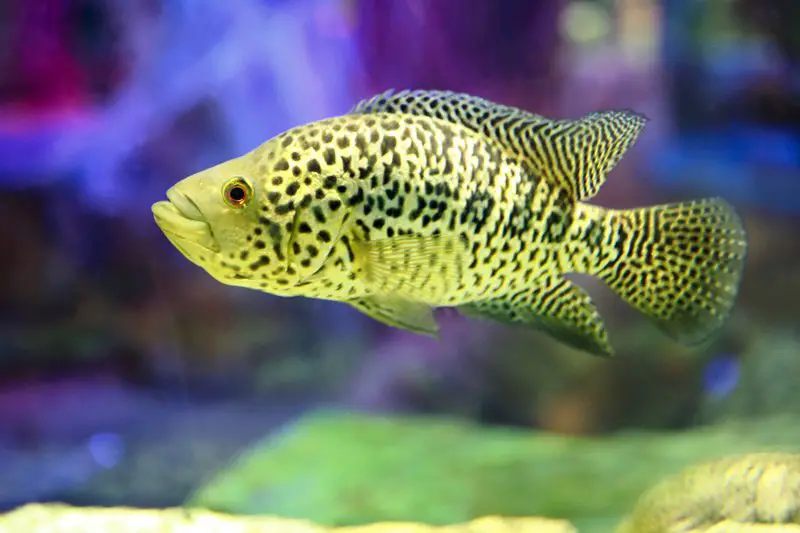
Jaguar cichlids require a fair amount of care and attention. They can be quite a challenge for a beginner aquarist. You should wait until you have some experience before introducing this species into your home aquarium.
As large fish, jaguar cichlids need plenty of space to swim around. Their water conditions should mimic those of their natural habitat in the rivers and lakes of Central America. They don’t need many plants but do need rocks and driftwood to give them places to hide.
You should feed your jaguar cichlid meat-based foods to cater to its carnivorous diet. The jaguar cichlid is highly aggressive and will try to eat other fish that are smaller than itself.
The jaguar cichlid is prone to certain diseases. The most common ailment to affect this fish is the disease known as ich.
Habitat and Tank Requirements
The jaguar cichlid is used to the murky waters of the lakes and rivers in Honduras and Costa Rica, which are thick with vegetation. When kept in a tank, the jaguar cichlid needs similar water conditions.
A single young jaguar cichlid will be happy starting out in a 30-gallon tank, but it will eventually outgrow this tank. A fully grown adult jaguar cichlid needs at least a 70-gallon tank. The bigger the tank, the better.
The following water parameters should be provided for your jaguar cichlid in a freshwater tank:
- pH: 7.0–8.7
- Water hardness, or dGH: 10–15
- Water temperature: 73°–82° Fahrenheit
- Tank size: minimum 70 gallons
The substrate should be composed mostly of sand, to allow the jaguar cichlid opportunities to dig. Jaguar cichlids have large mouths, so avoid using gravel with stones that can get lodged in their throats.
Synthetic plants are best used in the tank because the jaguar cichlid will try to eat live plants. You should also place some rocks and a few pieces of driftwood in the tank, to create some hiding places.
You will need a strong filter to cope with the large amount of waste that the jaguar cichlid produces on a daily basis. A powerful pump is handy in providing a strong current and water flow.
Tank Mates
The jaguar cichlid has an extremely aggressive temperament. It will turn on any smaller fish that shares its tank. As a highly territorial fish, the jaguar cichlid will see any newcomer to its tank as a threat to its space.
The best tank mates for the jaguar cichlid are other jaguar cichlids.
If you want more than one jaguar cichlid, the fish should be bought at the same time, preferably when they’re young, so that they can grow up together.
The jaguar cichlid can also be paired with other fish of a similar size that will be able to hold their own against the jaguar’s aggressive nature.
Many other cichlid species would be suitable tank mates for the jaguar cichlid. Some suggested tank mates are:
You should avoid placing live non-fish tank mates like shrimp and snails in the tank. The jaguar cichlid will probably eat them.
Disease
Ich is a common disease that affects many aquarium fish, including the jaguar cichlid. This disease presents as white spots on the body and around the mouth of the fish. It is a highly contagious disease and spreads rapidly.
As soon as you notice the first tell-tale white spots of ich, you should isolate the affected fish in a quarantine tank. Treat the fish with drops, available at most pet stores. You should replace 50% of the water in the original tank, and treat this water with drops.
Once the spots have cleared up completely on the affected fish, wait a few days before reintroducing it to the main tank.
Diet and Feeding
The jaguar cichlid is a carnivore. Because of its aggressive nature, it will try to eat any small live creatures that are placed in its tank. You should feed your jaguar cichlids a meat-based, protein-rich diet of blood worms, brine shrimp, and insects. These can either be fresh or frozen.
The jaguar cichlid will also eat commercial fish flakes and pellets if these are introduced at an early age. You should feed your jaguar cichlid on a regular schedule, twice a day.
Take care not to overfeed your fish. Your jaguar cichlids should be able to finish their food within five minutes. Any food that remains after five minutes is probably excessive.
Overfeeding can be dangerous and may cause your jaguar cichlid to become bloated and constipated. This can have serious consequences.
Breeding

Jaguar cichlids are relatively easy to breed. When there are a few males and females together in a tank, they tend to choose a partner and pair up naturally.
If you want to encourage breeding, you should raise the temperature of the tank’s water by 2 or 3 degrees, and replace half the water twice a week. Feeding your jaguar cichlids high-quality, protein-rich live food will also help to stimulate the breeding process.
As the breeding time approaches, you might notice that the paired-up fish start to behave more aggressively towards their tankmates. As soon as you notice this change in behavior, it’s time to move the two fish into a separate tank.
The female jaguar cichlid’s belly will become bloated and swollen as it fills with eggs. She will find a suitable spot under a rock or in a cave to lay her eggs. Female jaguar cichlids can produce as many as 2000 eggs at a time. The eggs are usually bright orange.
The male will fertilize the eggs as soon as they have been laid. Unlike most other fish, jaguar cichlids have natural parenting instincts. Both parents will guard the eggs fiercely until they hatch after 5 or 6 days.
The female will protect her young fry, and the male will hover nearby to ensure that they are safe. After about a week, the fry will start swimming around the tank, and you should then remove the adult fish before they get tempted to eat their offspring.
You should feed the fry regular minuscule portions of live food, such as tiny brine shrimp and small pieces of blood worms.
Should You Get a Jaguar Cichlid for Your Aquarium?
The jaguar cichlid comes with a few challenges. In spite of this, or perhaps even because of this, the jaguar is a wonderful fish to have in your aquarium.
Keeping a fish that requires a higher level of nurturing and seeing it thrive under your care is extremely satisfying. The jaguar cichlid is a big fish that will be a talking point among your fellow fishkeeping enthusiasts.
If fishkeeping is still a new hobby for you, you should wait until you have gained some experience before taking on the jaguar cichlid. However, if you’re an experienced aquarist, and you think you’re able to provide the necessary care and take on a long-term commitment, then you should consider keeping a jaguar cichlid or two in your tank.

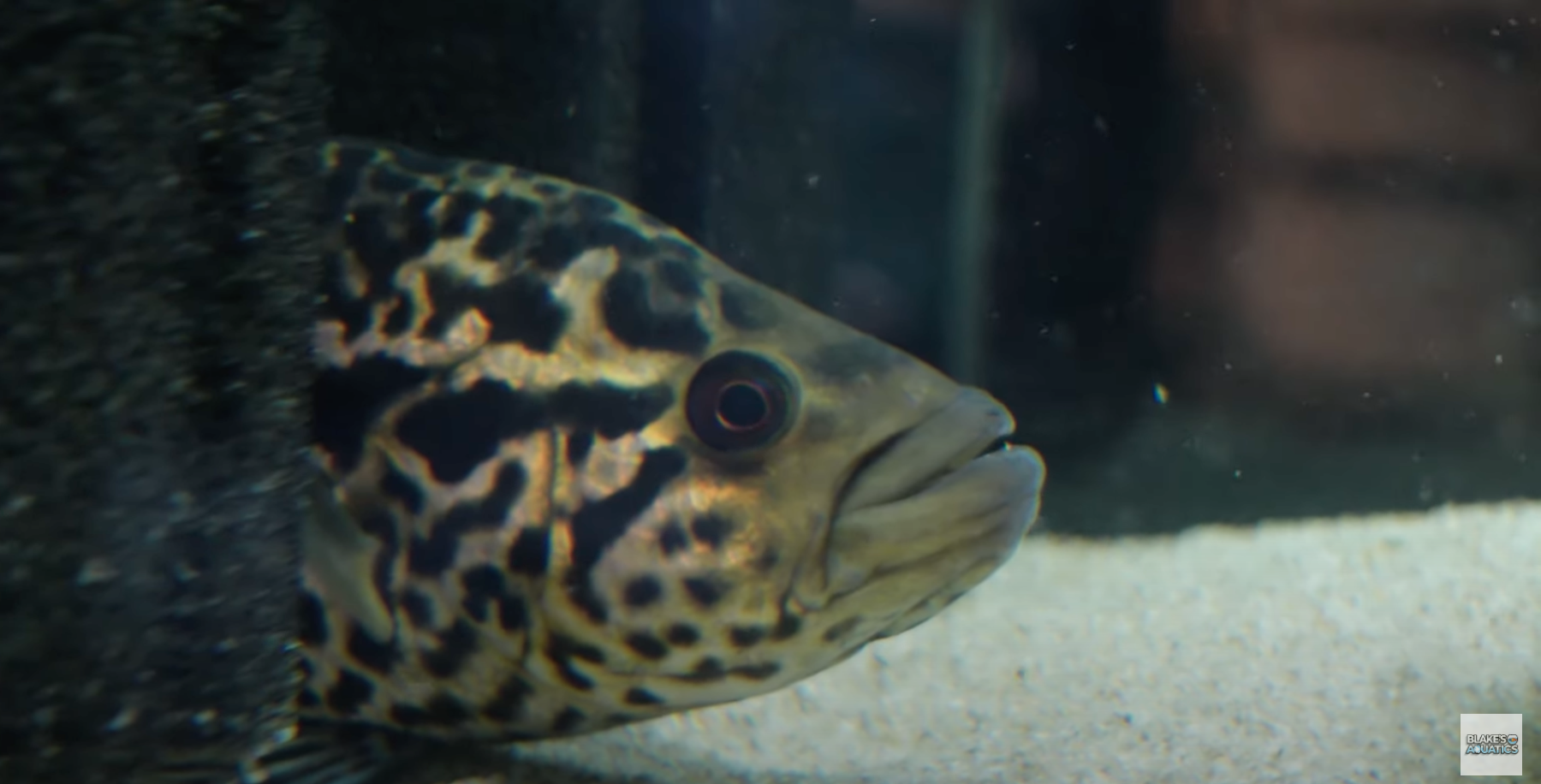
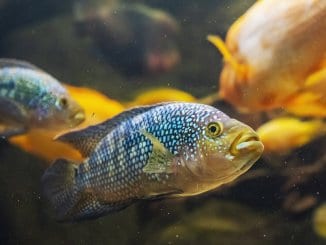
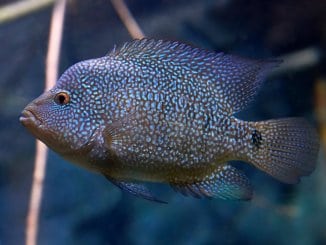
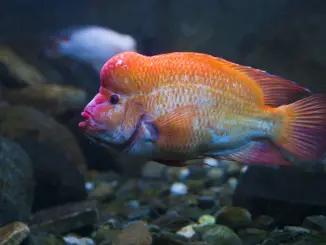
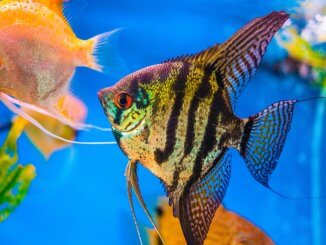
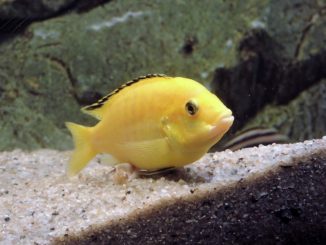
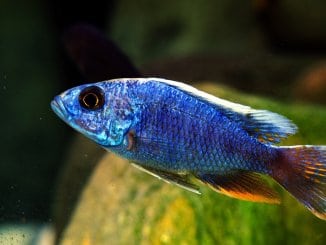

Be the first to comment